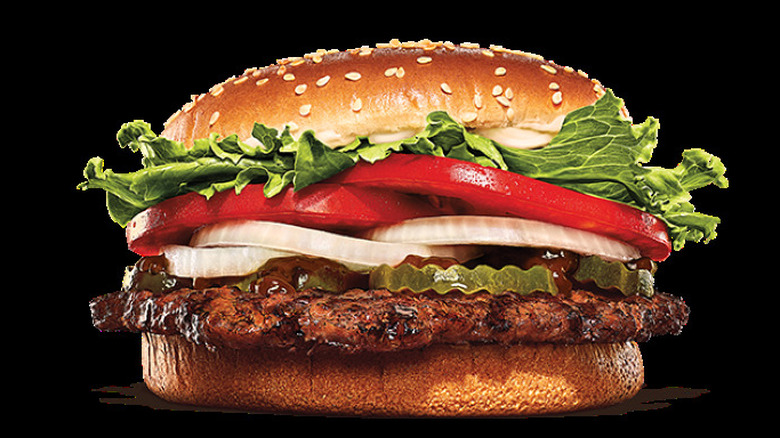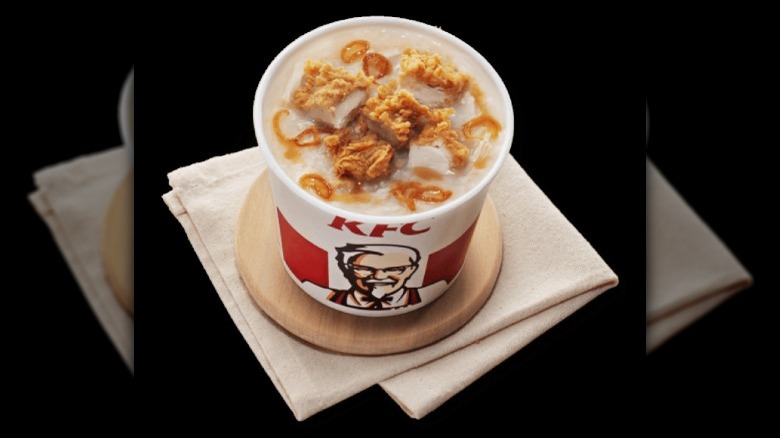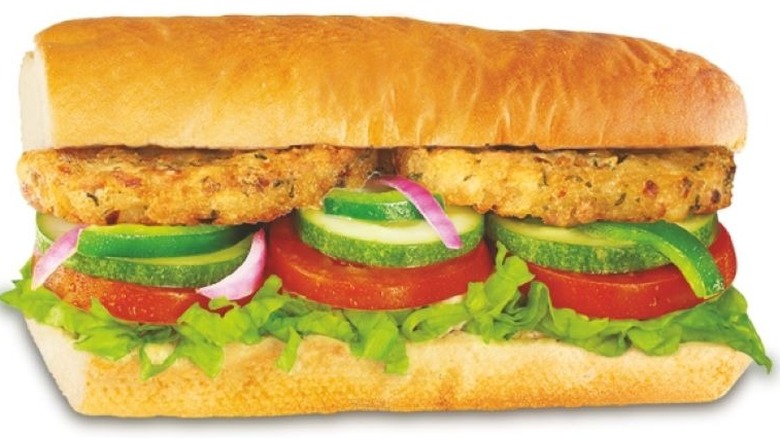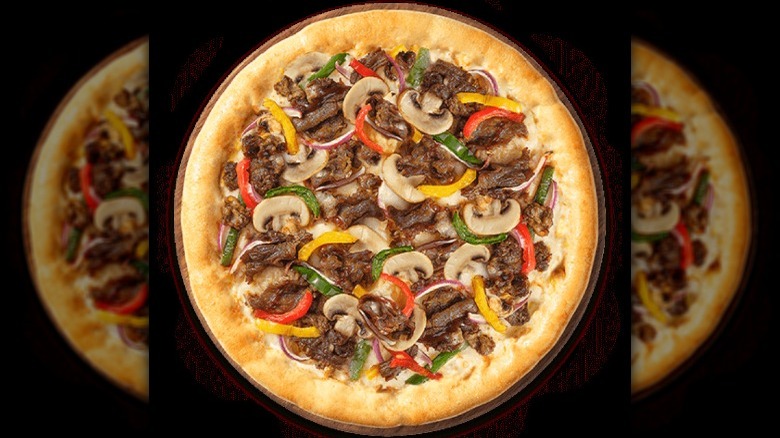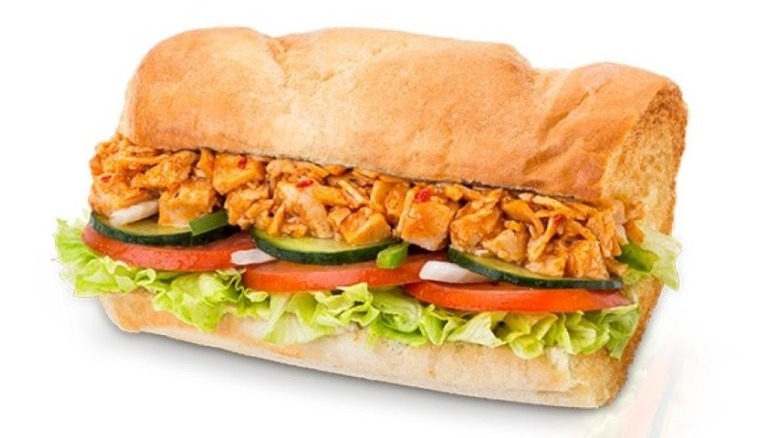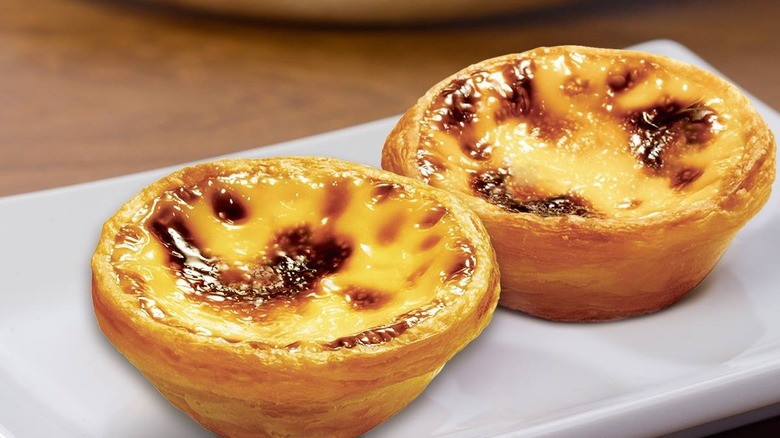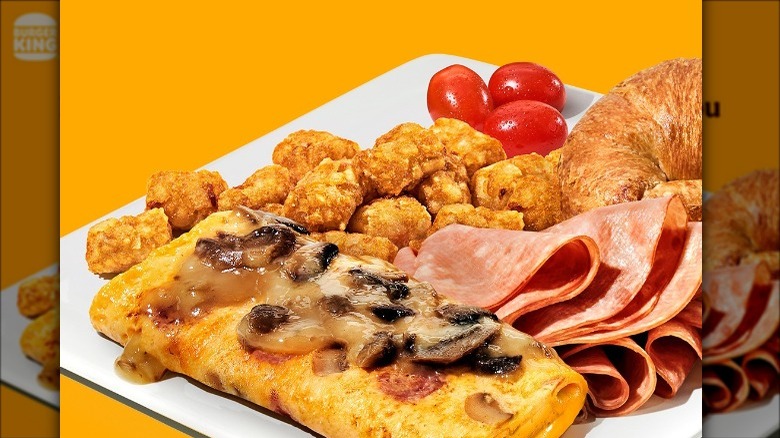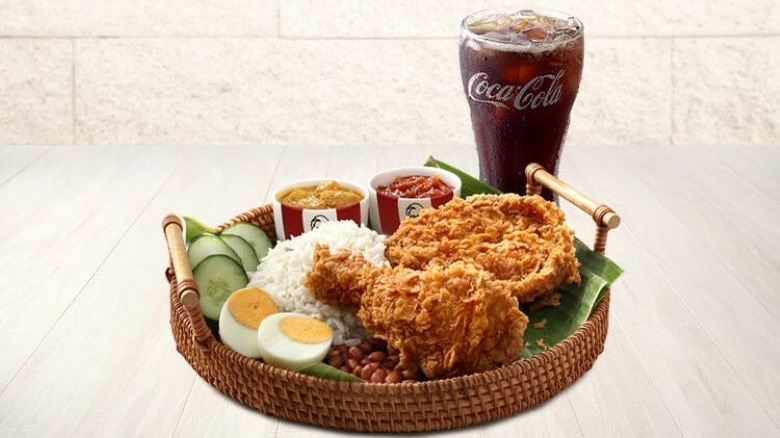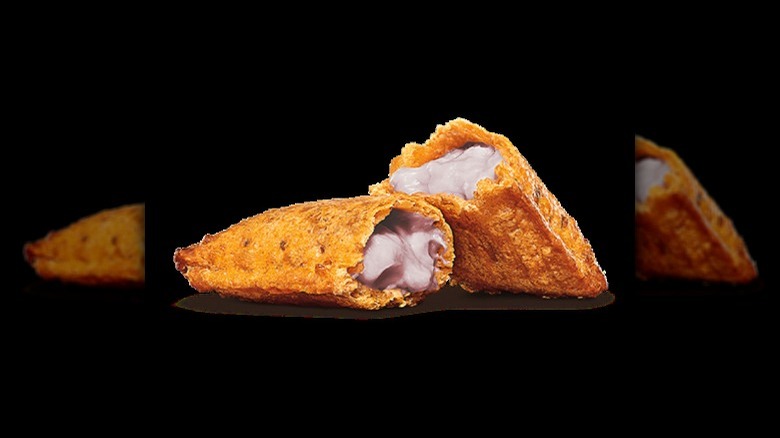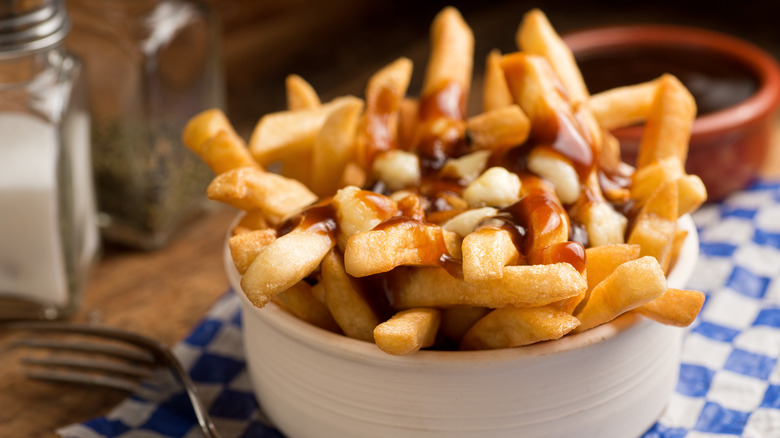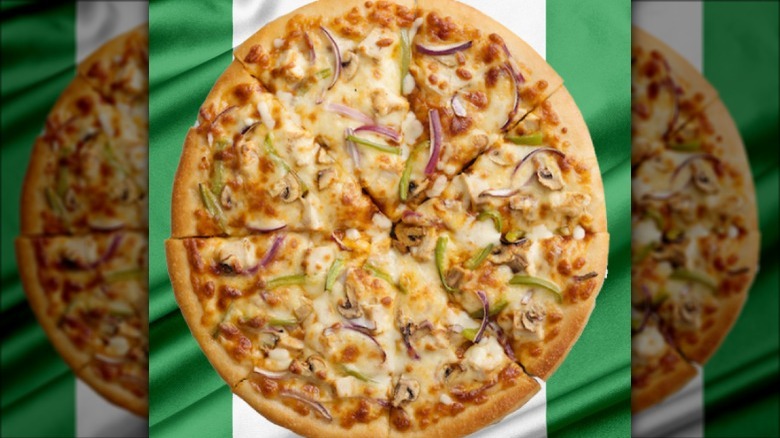Fast Food Items That Are Only Available Outside The US
Fast food was born and shaped in the United States, but the idea of fast service has long spread beyond American borders, and every big American franchise has at least tried to go international. It is now almost impossible to travel anywhere in the world and not see the flashy Burger King logo or the bright red KFC billboards depicting Colonel's silhouette. For a successful venture into an international market, each franchise had to determine what would work best at a particular location and then tailor the menu according to local preferences. This often meant adding items that were never part of the original American menus.
This round-up features the most interesting international fast-food items you can't get in the U.S. The list includes some of the biggest names in the industry to show how they adapted their offers to fit into the local culinary narrative, creating legions of fans along the way. Some took signature items and tweaked them with regional ingredients, while others changed things entirely. Though some of these dishes would be an attractive addition to the somewhat monotonous fast food fare in the U.S., it's questionable if they would perform well or create enough profit for these fast-food heavyweights if they were taken out of their natural habitat.
Bulgogi Whopper – Burger King – South Korea
The Whopper is Burger King's signature burger and one of the standard items at American and international outlets. In the U.S., you will sometimes see the classic version — which combines a grilled beef patty, lettuce, tomatoes, pickles, onions, mayonnaise, and ketchup — tweaked and released as a limited or seasonal offer, but at Burger King's international locations, you can find several Whopper variations that are a part of the standard menu. One of those is the Bulgogi Whopper, a combination of a classic Whopper and a sweet bulgogi sauce that can be found at South Korean Burger King.
MasterClass explains that bulgogi is a classic South Korean BBQ marinade typically used for beef or pork. It is based on soy sauce and usually includes some sweet add-ins that deliver thicker texture and complex flavors. Burger King's Bulgogi Whopper is the classic combo of beef and the usual Whopper condiments but with an added layer of sweet bulgogi sauce that coats the patty.
South Korean Burger King carries several other unique local items, such as the quirky shrimp and meat burger that has never graced American menus. Though we're not sure about the surf and turf mix, the bulgogi-flavored burger sounds like a mouthwatering combo.
Chicken Porridge – KFC – Malaysia, Singapore
If you typically associate porridge with a nourishing bowl of cooked oats topped with a drizzle of honey and some fruit, you might be surprised that porridge is not synonymous with oats and that your favorite breakfast can also be made in a savory version. Oats may be the most common choice for a classic porridge, but other grains, such as barley and buckwheat, can be cooked down until they attain that soft and mushy porridge-like consistency. Asian tradition, however, relies on rice as the region's most bountiful grain. You will typically find Asian-style rice porridge served as a savory breakfast, often labeled as congee (via Breakfast Cure).
To better suit the local tastes, KFC decided to add this savory rice porridge to its breakfast menu. You will find the item at several Asian outlets — such as KFC Malaysia and Singapore — where savory porridge is a traditional breakfast staple. KFC describes it as a combination of jasmine rice coupled with the chain's signature fillets and garnished with fried shallots and sliced spring onions. Though it sounds like a nourishing and filling breakfast dish, we doubt that we will ever see this hearty rice porridge on U.S. menus, as it doesn't fit into the traditional idea of American breakfast.
Aloo Patty Sub and Wrap – Subway – India
India is heaven for vegetarians. Indian cuisine is packed with vegetable-forward specialties and numerous dishes where veggies take center stage. Some of the most notable examples include the lentil-based dal or chana masala, which perfectly blends tomatoes and chickpeas into a spicy, curry-like dish. Spices are also paramount in Indian cuisine. You will find a wide selection of spices and blends to amp up the flavor of most dishes.
In a country that heavily relies on vegetables, it's reasonable that international fast-food chains would adapt to these regional traditions. One of them is Subway, the global sandwich chain with many stores scattered across the country. Subway tailored its local offerings based on traditional Indian culinary practices, and the menu features several sandwiches directly inspired by Indian dishes. One of the best representatives is the Aloo Patty sub — aloo is a reference to the potato base — that comes packed with spiced potato patties and your choice of veggies. Besides the sandwich version, Subway offers the same ingredients neatly packed inside a tortilla wrap.
Taquito Lupita – Taco Bell – Spain, Portugal
If you have never tried taquitos at your local Mexican joint, these crisp treats are best described as filled and rolled tortilla shells that are deep-fried until golden. The result is a thin, convenient snack perfect for dipping in sauces. Though taquitos usually come filled with beef, cheese, or chicken and are generally enjoyed as a savory dish, Spanish Taco Bell decided not to confine taquitos to their traditional role but instead turn them into a fantastic ice cream partner. The Taquito Lupita is a quirky yet wonderful Taco Bell creation that combines vanilla ice cream, dulce de leche sauce, and a sprinkle of cinnamon sugar with a hefty, deep-fried taquito stick. Because of its fantastic shape, the taquito works as a spoon, so you can easily scoop that creamy mix of vanilla ice cream and caramel.
Apart from Spain, this specialty is also available in Portugal. Taquito Lupita is one of those things we wouldn't mind seeing at Taco Bell in the States, and we would especially appreciate seeing it featured as a refreshing summer dessert.
Bulgogi Pizza – Pizza Hut – South Korea
We've already seen bulgogi marinade — that sweet South Korean mix made with soy sauce — featured on the list, but this time, it comes from another fast-food franchise in a slightly different format. Unsurprisingly, it also comes from South Korean outlets. If you look at the South Korean Pizza Hut menu, you will see some familiar names such as the Super Supreme, but among the whole selection, Bulgogi Pizza stands out as the most distinctive South Korean-inspired item. The pizza has a classic shape and comes topped with slivers of bulgogi-style beef, sliced mushrooms, and red and green peppers.
The chain offers two bulgogi-based pizzas: the basic Grilled Bulgogi and the amped-up BBQ Bulgogi version that combines bulgogi beef with sausages and comes drizzled with a sweet honey-mustard sauce. Of course, you can adapt both pizzas by stuffing the crust with cheese or garnishing them with additional toppings, but we have to say the suggested combination sounds good as is, so maybe you shouldn't mess with tradition.
Peri Peri Chicken – Subway – South Africa, India
You might have heard about the peri-peri sauce, but have you ever investigated the amazing history of this fiery condiment? SBS explains that peri-peri resulted from rather complex Portuguese-African history. Although there is no consensus on who whipped up the first peri-peri, it seems that the sauce was created when the Portuguese came across bird's eye chili peppers on African soil. The sauce eventually got its name from the native name for these hot peppers. Peri-peri unquestionably has African origins, and though it attained international fame with Nando's and its piri-piri chicken, the sauce is commonly used in several African regions. Chef Duncan Welgemoed explained to SBS that it is a star ingredient in South African cuisine, and as such, it was embraced by local fast-food restaurants. One of the best examples of how to properly implement peri-peri comes from Subway.
Peri Peri Chicken appears on Subway's South African menu, and as described, it consists of shredded chicken breast coated in Peri Peri sauce. The chicken is served inside a bread roll and garnished with some fresh veggies. The franchise also offers the same combinations, sans bread, in a salad form.
Interestingly, a similar item is available in India and Pakistan, but judging by the appearance, the South African version comes with thinner, shredded chicken pieces.
Egg Tarts – KFC – Singapore
Egg tarts are mini-sized open-faced pastries consisting of a crispy shell that holds a generous amount of egg custard filling. If the description reminds you of Portuguese pastel de nata, you wouldn't be wrong, as this Asian version is a direct descendant of the Portuguese original but with some Cantonese and British influence. As Taipei Times explains, the tart was created in Macao, which was once a Portuguese colony. Though it resembles the legendary Portuguese version, the filling is slightly denser and mimics traditional British custards. One of the most famous egg tart renditions is sold by Margaret Wong, the legendary bakery owner who eventually sold her recipe to KFC.
The franchise added egg tarts to its regional menu in 2013. As these custardy treats are still featured in several Asian outlets — including China and Singapore — it seems that KFC made a savvy business decision by introducing them to the local market. But let's be honest, the combination of flaky pastry and sweet, custardy filling would be a welcomed addition to any market, so we can only hope to see its influence spread outside of Asia.
Omelette Platter – Burger King – Singapore
Burger King's American breakfast menu is probably one of the best we've ever seen at a fast food restaurant. The variety is extensive and currently includes several biscuit combinations, a decent number of croissant-based sandwiches, an egg burrito, and hash browns. The menu also features pancake platters and combos. And though all the items seem appealing and inviting, Burger King in Singapore carries one breakfast dish that sounds so filling and wholesome that we would petition to have it on the American menus.
Turkey Ham & Cheese Omelette Platter is a part of the regular breakfast menu in Singapore. The combination includes the classic ham and cheese omelet served with turkey sausage, a handful of hash browns, and some cherry tomatoes. Though the description doesn't specify, the image shows that a flaky croissant is added to the mix. The combination sounds like it was made in breakfast heaven and has some serious international potential, so don't be surprised if you soon see it at other Burger King locations.
Nasi Lemak – KFC – Malaysia
Nasi lemak is often labeled as the Malaysian national dish, though it's better described as a multi-dish meal. Each portion of nasi lemak will incorporate the most important regional ingredient — a heap of rice, which will be flavored with coconut and pandan. A boiled egg is standard, along with cucumbers, fried anchovies, and nuts. Sambal — the fiery red chili paste generously used in the region — is an essential part of the dish, and you will often see nasi lemak served with some type of protein. Though there are seemingly endless varieties, most locals agree that nasi lemak is a proper breakfast dish (via Buro247).
Nasi lemak is available everywhere in Malaysia, and KFC decided to join the local tradition. The fast-food magnate features the dish on its menu, and naturally, it makes it part of the standard breakfast menu. You can have the no-chicken option or order your Nasi lemak with a side of KFC's signature fried chicken — you can also choose between a fillet or a drumstick version. Though we're not sure about the whole breakfast thing, this local special sounds like a perfect partner to KFC's chicken.
Taro Turnover – Burger King - Singapore
Singaporean Burger King has a fair share of unique dishes that the company never released in the U.S. Along with the previously mentioned omelette plate, one dessert also makes a list, and it's different from anything you will find on Burger King's American menu. The Taro Turnover is a deep-fried hand pie brimming with bright purple taro filling. If you're unfamiliar with taro, it is best described as a bulb-like root indigenous to Southeast Asia. It is typically used in desserts, and the earthy flavor is faintly reminiscent of what you will find in sweet potatoes. Taro always has some purple hue, though it can vary in intensity (via MasterClass).
Burger King is not the franchise we typically associate with deep-fried hand pies, but it seems that international outlets are lucky enough to have several of them on their menus. While Singapore currently has the taro version, Malaysian stores carry a classic apple pie. If your idea of an ideal dessert includes juicy fruit coated in flaky pastry, you will not find any similar items at Burger King's locations in the States. Still, you can hope the franchise will reintroduce the legendary apple pie that was discontinued in 2020.
Poutine – Burger King – Canada
Poutine can easily be classified as a Canadian national dish. Britannica describes it as an unpretentious combination made with french fries topped with cheese curds and then doused in gravy. Poutine is also one of the Burger King items you can't get in the U.S., as it's only available on the Canadian menu. Along with the classic option, the offer includes poutine with bacon and a spicy variety labeled Angry Poutine. According to QSR Web, the upgraded versions were added because the classic proved to be incredibly popular — apparently, Burger King gets over 78.6 million orders of poutine per year. The Angry version is amped up with sliced jalapenos, fried onions, and a drizzle of the signature Angry sauce, while the bacon version comes garnished with a generous amount of — you guessed it — fried bacon.
A combination of cheese, fries, and gravy sounds like heaven for our taste buds, so we're a little surprised that the dish hasn't been copied in American outlets as it would be a welcomed upgrade from the standard fries and ketchup combo that is usually ordered with a BK burger.
Suya Pizza – Pizza Hut – Nigeria
Suya is a Nigerian national specialty. Consisting of thinly sliced, grilled beef, it is an affordable and available dish, equally loved by everyone in the country. Though there are slight regional differences, typical suya will incorporate thin slices of spice-rubbed beef that are skewered and then grilled over charcoal. The spice blend often includes hot peppers, so suya typically has a nice spicy kick (via The Ann Arbor News). As it's such an essential part of Nigerian culinary tradition, suya was adopted by regional fast-food outlets, and it was perhaps best used by Nigerian Pizza Hut.
The chain offers a chicken-based suya option with BBQ sauce, onions, and green peppers, while the meat-packed triple suya brings beef, pepperoni, and slices of cured and smoked mutton to the mix. Nigerian Pizza Hut has a nice selection of internationally or regionally inspired specials, so you can also find a Tikka-inspired variety and a spicy Peri Peri version.
Simit – Burger King – Turkey
Simit is a Turkish-style bread that is best described as a close relative to a traditional pretzel. It is a round bread that is generously coated in sesame seeds. It is typically sold by street vendors and enjoyed for breakfast. Ideally, you would nibble on a freshly baked, crispy simit and sip traditional Turkish tea on the side, but this bread perfectly fits in any breakfast environment. Though it is technically not considered fast food, simit is such an integral part of local dining culture that Burger King decided to add it to its regular menu in Turkey. The simit that comes from Burger King is classic; a perfectly baked, sesame-studded, lightly twisted, caramelized roll.
Along with simit, Turkish Burger King carries açma, a small-sized bread roll that could easily pass as a bagel. The rest of the menu is also infused with Turkish tradition but includes several heartier options, such as cheese-packed buns and veggie or smoked meat sandwiches.

